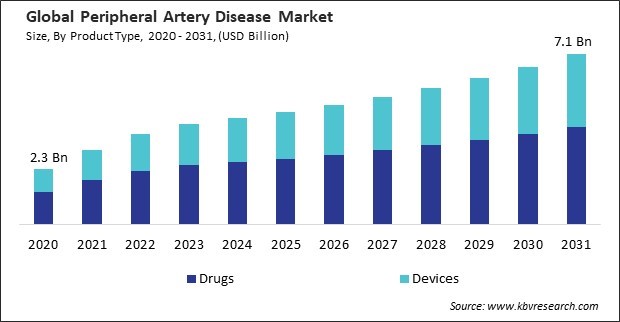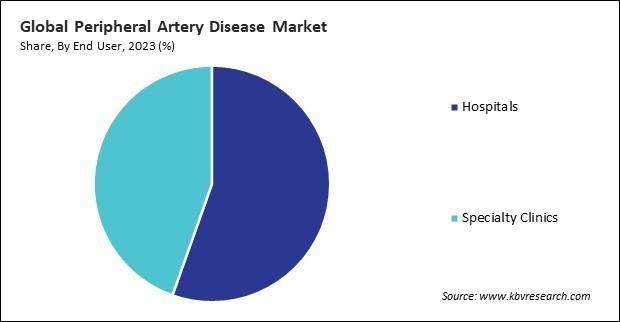“Global Peripheral Artery Disease Market to reach a market value of USD 7.1 Billion by 2031 growing at a CAGR of 6.9%”
The Global Peripheral Artery Disease Market size is expected to reach $7.1 billion by 2031, rising at a market growth of 6.9% CAGR during the forecast period.
Europe has a high prevalence of PAD risk factors, including an aging population, high rates of smoking, and increasing incidence of diabetes and hypertension. Europe's strong healthcare systems, particularly in countries like Germany, France, and the United Kingdom, contribute to the region's significant market share. Consequently, the European region would acquire nearly 30% of the total market share by 2031.

Parotid artery disease is a common cardiovascular disorder that frequently results in mobility challenges and discomfort. High blood pressure, or hypertension, is an additional significant risk factor for PAD. According to the World Health Organization (WHO), hypertension affects approximately 1.28 billion adults aged 30-79 years everywhere in the world. Hence, as the prevalence of PAD continues to rise, the demand for effective treatments and management strategies will drive market growth.
Additionally, the rapid advancements in medical technology are significantly transforming the landscape of PAD treatment, offering new hope and improved patient outcomes. Minimally invasive procedures are another area where technological advancements have profoundly impacted. Thus, such advancements are driving the growth of the market.
However, Drug-eluting stents, atherectomy devices, and minimally invasive procedures, while highly effective, come with substantial price tags that can be prohibitive for many patients. Furthermore, the high costs associated with advanced PAD treatments can stifle innovation and market growth. Hence, the high cost of advanced PAD treatments is a significant barrier to market growth.
Moreover, the economic downturn of the pandemic also posed significant challenges. Many individuals faced financial hardships due to job losses and reduced incomes, affecting their ability to afford medical care. High treatment costs, already a barrier for many PAD patients, became even more prohibitive during the pandemic. Healthcare providers also faced significant challenges during the pandemic. Thus, the pandemic had an overall negative impact on the market.
Based on product type, the market is bifurcated into devices and drugs. The devices segment procured 41% revenue share in the market in 2023. In advanced cases where pharmaceutical treatments alone are insufficient, medical devices are essential for the diagnosis, intervention, and management of PAD. The devices segment includes various products such as diagnostic imaging tools, angioplasty balloons, stents, and atherectomy devices.

On the basis of end user, the market is classified into specialty clinics and hospitals. The specialty clinics segment witnessed 45% revenue share in the market in 2023. Specialty clinics are known for their patient-centered approach, providing personalized care plans and closer patient monitoring. Improved health outcomes are the result of this emphasis on individualized treatment, which also increases patient satisfaction and patient adherence to treatment protocols.
Free Valuable Insights: Global Peripheral Artery Disease Market size to reach USD 7.1 Billion by 2031
Region-wise, the market is analyzed across North America, Europe, Asia Pacific, and LAMEA. The North America segment garnered 39% revenue share in the market in 2023. There are numerous factors that contribute to this dominance, including the high prevalence of PAD risk factors in the region, including diabetes, hypertension, obesity, and smoking.
| Report Attribute | Details |
|---|---|
| Market size value in 2023 | USD 4.2 Billion |
| Market size forecast in 2031 | USD 7.1 Billion |
| Base Year | 2023 |
| Historical Period | 2020 to 2022 |
| Forecast Period | 2024 to 2031 |
| Revenue Growth Rate | CAGR of 6.9% from 2024 to 2031 |
| Number of Pages | 295 |
| Number of Tables | 470 |
| Report coverage | Market Trends, Revenue Estimation and Forecast, Segmentation Analysis, Regional and Country Breakdown, Porter’s 5 Forces Analysis, Company Profiling, Companies Strategic Developments, SWOT Analysis, Winning Imperatives |
| Segments covered | Product Type, End User, Region |
| Country scope |
|
| Companies Included | Becton, Dickinson and Company, Bayer AG, Koninklijke Philips N.V., Abbott Laboratories, Terumo Corporation, B. Braun Melsungen AG, Medtronic PLC, Boston Scientific Corporation, Cardinal Health, Inc. and Biotronik SE & Co. KG |
By Product Type
By End User
By Geography
This Market size is expected to reach $7.1 billion by 2031.
Increasing prevalence of peripheral artery disease (PAD) are driving the Market in coming years, however, Competition from alternative therapies restraints the growth of the Market.
Becton, Dickinson and Company, Bayer AG, Koninklijke Philips N.V., Abbott Laboratories, Terumo Corporation, B. Braun Melsungen AG, Medtronic PLC, Boston Scientific Corporation, Cardinal Health, Inc. and Biotronik SE & Co. KG
The expected CAGR of this Market is 6.9% from 2024 to 2031.
The Drugs segment led the Market by Product Type in 2023; thereby, achieving a market value of $4.1 billion by 2031.
The North America region dominated the Market by Region in 2023, and would continue to be a dominant market till 2031; thereby, achieving a market value of $2.6 billion by 2031.
Our team of dedicated experts can provide you with attractive expansion opportunities for your business.

 Drivers
Drivers
 Restraints
Restraints
 Opportunities
Opportunities
 Challenges
Challenges
